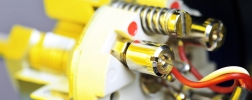There are many reasons for using electrical thermometers with short response times: optimisation of the efficiency, more efficient utilisation of the working range of a process, avoidance of thermal overload of the process medium. But how are response times measured, …
Resistance thermometer
Temperature calibration: Thermocouples vs. resistance thermometers
Katja Strecke | Know-howIn temperature calibration, high demands are placed on reference thermometers in terms of accuracy and reproducibility and thus long-term stability. Therefore, RTDs (“resistance temperature detectors”) – here specifically platinum resistance thermometers – and …
Natural gas: On-site calibration optimised at the metering skid
Jing Lyu | ApplicationsOn-site calibration of measuring instruments is often very time-consuming and expensive. This is especially true for applications with several measurands. One example of this is the metering skid, a system for the custody transfer measurement of the amount of natural …
China Compulsory Certification (CCC) for electrical thermometers
Joachim Brückner | TemperatureThe “China Compulsory Certification (CCC)” is a certification system of the People's Republic of China. Since 1 October 2020 it is, for example, no longer permissible to place explosion-protected electrical thermometers (resistance thermometers and thermocouples) …
Pt100 in class B or F 0.3 – what does IEC 60751 say?
Roland Sachs | Know-howPerhaps you've already noticed that in some instances a Pt100 is specified with an accuracy class B or A. At other times, it has the class F 0.3 or F 0.15. This blog post looks at the specifications for Pt100 in the international IEC 60751 standard and explains the …






